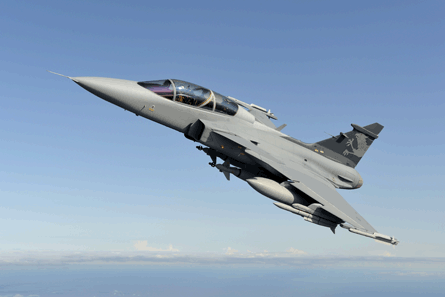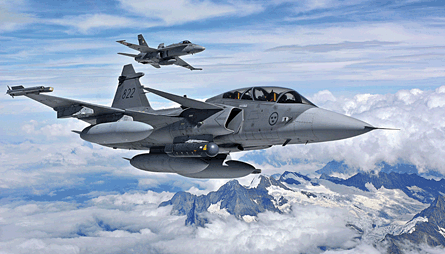Saab is reporting an unprecedented level of interest in its flagship Gripen combat aircraft, despite a high-profile and ongoing spat with the Norwegian defence ministry, which last November rejected its next-generation offering in favour of Lockheed Martin's F-35 Joint Strike Fighter.
"We're saturated with opportunities at the moment," says Bob Kemp, senior vice-president sales and marketing for Gripen International. The company fielded five requests for proposals in 2008, plus four requests for information, he says. "As an organisation we're established to handle one RFP and one RFI a year. People were pretty busy."
Last year's Farnborough air show in the UK saw Gripen host 37 government delegations, and while some of these are cited as long-term prospects at best, others are very serious on making acquisitions. Kemp lists 10 countries as potential buyers within the next five years: Brazil, Bulgaria, Croatia, Denmark, Greece, India, the Netherlands, Romania, Slovakia and Switzerland.
NEW OPPORTUNITIES
And new opportunities continue to emerge. Early dialogue has recently been held with Argentina and Malaysia, and the company is also eyeing the needs of Oman, long tipped as a future Eurofighter Typhoon buyer. "It's not a done deal," says Kemp. "The price of oil has come down and the price of Eurofighter has gone up. Maybe the door is still open." Dassault is also touting its Rafale to the nation.
 |
|---|
© Katsuhiko Tokunaga/Gripen International |
For many of its potential customers, the promise of Saab's next-generation Gripen NG has prompted interest, as it will have longer range, increased payload and a more powerful engine than the current production-standard C/D model.
Saab last year unveiled and flew its two-seat Gripen Demo airframe for the first time, and this has now flown 79 times, de-risking several key technologies destined for the programme's next production phase.
Milestones have included flying at more than Mach 1.6, demonstrating the fighter's "supercruise" performance (the ability to maintain supersonic flight without using afterburner) at more than M1.2, and reaching its maximum angle of attack. It has also flown at its maximum loading, including representative models of MBDA's Meteor beyond visual-range air-to-air missile.
The Demo has received backing from numerous companies. Highlighting General Electric, which has given two F414G engines and engineering support to the project, Kemp says: "There's a belief in industry in Gripen. They believe in the future."
The aircraft has been in the workshop since early April being readied for its second test phase. This will introduce missile approach warners and satellite communications equipment and, from later this year, an active electronically scanned array (AESA) radar: Selex Galileo's Vixen 1000E/ES05 Raven.
Saab rolled out the Demo with an agreement to use an AESA demonstrator provided by Thales, but their relationship quickly crumbled. Thales says it withdrew the technology as it was already under contract for the Rafale, but Kemp gives a different explanation. "The radar wasn't good enough for what we needed to do," he says. "The Selex radar is seriously outstanding. When you brief people on the capabilities they are astonished."
Bob Mason, Selex Galileo's executive vice-president, radar and advanced targeting, says the Vixen 1000E's advantage comes from the use of a swashplate mounting, which enables the active array to be rotated by +/-100°. This beats a fixed AESA during beyond visual-range and off-boresight missile firings, and while acquiring synthetic aperture radar imagery, he says. "We will be delivering a prototype this year for them to fly, and then will upgrade it over the next 18 months."
TECHNOLOGY TRANSFER
Developed in Edinburgh, Scotland, the new system will be demonstrated to India, and Saab says the UK government has already approved it for export. New Delhi is seeking an initial 126 fighters under its $10-12 billion medium multirole combat aircraft (MMRCA) contest, with the Gripen NG up against the Rafale, Typhoon, Boeing F/A-18E/F Super Hornet, Lockheed F-16 and RSK MiG-29.
With the ability to transfer technology and industrial know-how a vital requirement for India and many other potential buyers, Saab points to its experience through selling 26 Gripens to South Africa, and in delivering large offset packages linked to lease deals with the Czech Republic and Hungary. "Handing over source code or transferring technology is natural for Sweden," says Kemp.
Sweden last year closed a deal to sell six Gripens - two Cs and four Ds - to replace some of Thailand's Northrop F-5s. Kemp says dislodging US suppliers from such traditional markets is Gripen's "toughest fight. At one time I thought that was impossible. But we are now seeing things start to change." However, economic constraints have led to Bangkok suspending plans to acquire another six.
 |
|---|
© Swiss Air Force |
Entering into such a market is not viewed as a one-off, and Kemp believes "non-aligned" nations such as Argentina, Brazil, India and Malaysia could follow. "This is a market that I really think we can secure," he says.
Best and final offers for Brazil's initially 36-aircraft FX-2 contest were due for delivery on 8 June, with the Swedish product again battling the Rafale and the Super Hornet. "It's not just about building the aircraft: it's about developing the aircraft," says Kemp. "Brazil can become a partner in our development programme. The competitors have a product to offer; not a programme." And he reveals that Saab has already held discussions with the Brazilian defence ministry about possible future collaboration on the development of a new fifth-generation strike aircraft.
Sensing an opportunity to challenge the dominance of larger European and US manufacturers, Saab could pursue a joint project with Brazil, India and South Africa, he adds.
Kemp believes the outcome of the contests in Brazil and India could have a seismic effect on the global fighter industry, potentially leading to one or two manufacturers withdrawing. "If you secure Brazil or India you're there. If you don't win those two, the question is: where do you find the future markets?"
India's MMRCA contest represents "the last throw of the dice" for Russia's RSK MiG, he claims, but adds that after New Delhi's selection "maybe it will be us, Dassault or Boeing who will opt out of the export market?"
In-country flight tests of the six Indian candidates are expected from late this year or early 2010, having slipped from an original target of April/May this year. Kemp says a contract could still be three or four years away, and that India's planned 2014 in-service date could drift to perhaps 2020. "The 'first six months' took 18," he notes.
EUROPEAN PROSPECTS
Closer to home, Denmark could make a selection around September or October this year, with the Gripen NG, JSF and Super Hornet in the offing. Switzerland should choose in early 2010 between the Gripen, Rafale or Typhoon, with best and final offers for the roughly 30-aircraft deal due in the third quarter of this year. Kemp is optimistic of a Gripen win, noting: "when you've got the right fighter and the right price it's got to be the best solution".
Saab also hopes that it will yet be able to contest the Netherlands' roughly 85-aircraft F-16 replacement, with a decision having been deferred until 2012. The Dutch air force currently favours the F-35, but Kemp questions whether the service's desire to field a "first night of the war" fighter tallies with the country's national defence policy.
The Norwegian defence ministry remains the focus of much discussion by Saab, which is still fiercely defending the Gripen's calibre after the criticism it received from Oslo last November. "We were compliant on over 1,200 requirements, but the air force were in love with the JSF," says Kemp. "It was not a fair competition."
Sweden last year underlined its commitment to keep investing in the Gripen until around 2025, ordering 18 new single-seaters and 13 two-seat trainers. Fresh success on the export stage would help Saab cement its place in the fighter sector, and raise the possibility that it could even develop a manned replacement for the Gripen over the coming decades.
"You need to have a strategic market to propel yourself for developing the next generation of aircraft," says Kemp. "We want to do it, and we have the skills in Saab and the Swedish industry base."
- All the latest news, images and video from the Paris Air Show
Source: Flight Daily News























